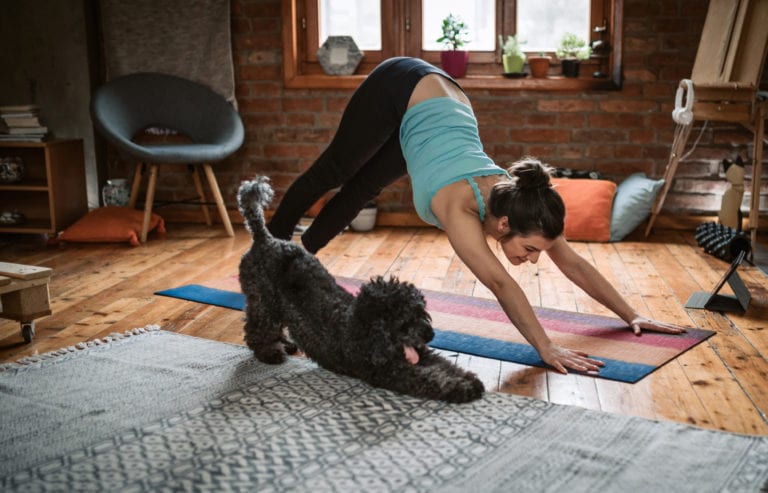Healthcare 101: 5 tips for staying fit indoors
March 5, 2020

We’ve all been there — we have the best intentions of exercising more, but life somehow gets in the way. And family needs or work demands can make it seem even more complicated.
That’s why we’re bringing you five ideas to help get in shape (or stay in shape) all from the comfort of your home. And as a bonus: These work even if other people (or friendly pets!) are hanging out with you!
Let’s get started!
1. Plan a complete fitness program.
Any well-rounded workout includes the same five building blocks: a warmup, some cardio, strength-building, flexibility work, and a cooldown.
Warmup
This can be as simple as doing slow jumping jacks or marching in place while swinging your arms. The idea is to get your muscles loose and warm before asking them to tackle your main workout — this goes a long way to prevent injury.
Cardio
Now it’s all about elevating your heart rate! This is the part where you should get a little out of breath, because your heart is pumping blood faster to deliver more oxygen throughout your body. This kind of exercise burns calories while keeping your heart and lungs healthy.
People often think of running when they think of cardio, but there’s way more to the story. We recommend checking out these 19 at-home, no-equipment cardio exercises instead.
Strength-building
Strength training is important because it builds muscle and conditions bones and joints. You can use weights here, but body weight-only exercises are highly effective, too. Here is an illustrated guide to 53 strength-building moves you can try at home.
Flexibility work
You’re almost to the end! Good, old-fashioned stretching is as important as ever to improve your range of motion and stave off injuries. It also feels great. Here are ten simple exercises for flexibility.
Cool down
Finally! This section should look similar to your warmup — just do very low-level cardio moves to bring your heart rate down.
2. Shoot for about half an hour of exercise five times a week.
When it comes to strength training, make sure to cover all the major muscle groups in your upper and lower body, abs, and back. Three sets of 10-15 repetitions for each exercise is a good starting point for beginners.
3. Use mental tricks to commit to your new at-home workout routine.
One of the downsides of exercising at home is that it’s easy to get distracted with pets, TV, and your glorious couch right there. Experts recommend you stay motivated by scheduling your workouts in advance on a calendar, journaling about your goals, and, if you can, finding an exercise partner.
4. Turn to YouTube to spice up your exercise options.
The platform is stocked with free videos from fitness gurus who show you how to work out safely whether you want to try kickboxing, yoga, or hip hop dance. (Questions about what video workouts might be right for you? Check with your primary care physician or another trusted healthcare professional.)
5. Try to incorporate more movement into your routine activities.
One final tip: Some days, you will still be hard-pressed to find 30 minutes to yourself. On those days, keep it simple and do little things like stretching while watching TV with your family.
These “mini fitness moments” will add up over the course of a day, making you stronger and bringing you closer to your goals.
Eager to see if your workouts are paying off? Keep an eye on your numbers with one of our many health tests and screenings at locations across the U.S.
